Haiyu Zhao
MaIR: A Locality- and Continuity-Preserving Mamba for Image Restoration
Dec 28, 2024Abstract:Recent advancements in Mamba have shown promising results in image restoration. These methods typically flatten 2D images into multiple distinct 1D sequences along rows and columns, process each sequence independently using selective scan operation, and recombine them to form the outputs. However, such a paradigm overlooks two vital aspects: i) the local relationships and spatial continuity inherent in natural images, and ii) the discrepancies among sequences unfolded through totally different ways. To overcome the drawbacks, we explore two problems in Mamba-based restoration methods: i) how to design a scanning strategy preserving both locality and continuity while facilitating restoration, and ii) how to aggregate the distinct sequences unfolded in totally different ways. To address these problems, we propose a novel Mamba-based Image Restoration model (MaIR), which consists of Nested S-shaped Scanning strategy (NSS) and Sequence Shuffle Attention block (SSA). Specifically, NSS preserves locality and continuity of the input images through the stripe-based scanning region and the S-shaped scanning path, respectively. SSA aggregates sequences through calculating attention weights within the corresponding channels of different sequences. Thanks to NSS and SSA, MaIR surpasses 40 baselines across 14 challenging datasets, achieving state-of-the-art performance on the tasks of image super-resolution, denoising, deblurring and dehazing. Our codes will be available after acceptance.
Exploiting Diffusion Priors for All-in-One Image Restoration
Dec 02, 2023



Abstract:All-in-one aims to solve various tasks of image restoration in a single model. To this end, we present a feasible way of exploiting the image priors captured by the pretrained diffusion model, through addressing the two challenges, i.e., degradation modeling and diffusion guidance. The former aims to simulate the process of the clean image degenerated by certain degradations, and the latter aims at guiding the diffusion model to generate the corresponding clean image. With the motivations, we propose a zero-shot framework for all-in-one image restoration, termed ZeroAIR, which alternatively performs the test-time degradation modeling (TDM) and the three-stage diffusion guidance (TDG) at each timestep of the reverse sampling. To be specific, TDM exploits the diffusion priors to learn a degradation model from a given degraded image, and TDG divides the timesteps into three stages for taking full advantage of the varying diffusion priors. Thanks to their degradation-agnostic property, the all-in-one image restoration could be achieved in a zero-shot way by ZeroAIR. Through extensive experiments, we show that our ZeroAIR achieves comparable even better performance than those task-specific methods. The code will be available on Github.
Variational Relational Point Completion Network for Robust 3D Classification
Apr 18, 2023Abstract:Real-scanned point clouds are often incomplete due to viewpoint, occlusion, and noise, which hampers 3D geometric modeling and perception. Existing point cloud completion methods tend to generate global shape skeletons and hence lack fine local details. Furthermore, they mostly learn a deterministic partial-to-complete mapping, but overlook structural relations in man-made objects. To tackle these challenges, this paper proposes a variational framework, Variational Relational point Completion Network (VRCNet) with two appealing properties: 1) Probabilistic Modeling. In particular, we propose a dual-path architecture to enable principled probabilistic modeling across partial and complete clouds. One path consumes complete point clouds for reconstruction by learning a point VAE. The other path generates complete shapes for partial point clouds, whose embedded distribution is guided by distribution obtained from the reconstruction path during training. 2) Relational Enhancement. Specifically, we carefully design point self-attention kernel and point selective kernel module to exploit relational point features, which refines local shape details conditioned on the coarse completion. In addition, we contribute multi-view partial point cloud datasets (MVP and MVP-40 dataset) containing over 200,000 high-quality scans, which render partial 3D shapes from 26 uniformly distributed camera poses for each 3D CAD model. Extensive experiments demonstrate that VRCNet outperforms state-of-the-art methods on all standard point cloud completion benchmarks. Notably, VRCNet shows great generalizability and robustness on real-world point cloud scans. Moreover, we can achieve robust 3D classification for partial point clouds with the help of VRCNet, which can highly increase classification accuracy.
ABLE-NeRF: Attention-Based Rendering with Learnable Embeddings for Neural Radiance Field
Mar 24, 2023



Abstract:Neural Radiance Field (NeRF) is a popular method in representing 3D scenes by optimising a continuous volumetric scene function. Its large success which lies in applying volumetric rendering (VR) is also its Achilles' heel in producing view-dependent effects. As a consequence, glossy and transparent surfaces often appear murky. A remedy to reduce these artefacts is to constrain this VR equation by excluding volumes with back-facing normal. While this approach has some success in rendering glossy surfaces, translucent objects are still poorly represented. In this paper, we present an alternative to the physics-based VR approach by introducing a self-attention-based framework on volumes along a ray. In addition, inspired by modern game engines which utilise Light Probes to store local lighting passing through the scene, we incorporate Learnable Embeddings to capture view dependent effects within the scene. Our method, which we call ABLE-NeRF, significantly reduces `blurry' glossy surfaces in rendering and produces realistic translucent surfaces which lack in prior art. In the Blender dataset, ABLE-NeRF achieves SOTA results and surpasses Ref-NeRF in all 3 image quality metrics PSNR, SSIM, LPIPS.
IntegratedPIFu: Integrated Pixel Aligned Implicit Function for Single-view Human Reconstruction
Nov 15, 2022Abstract:We propose IntegratedPIFu, a new pixel aligned implicit model that builds on the foundation set by PIFuHD. IntegratedPIFu shows how depth and human parsing information can be predicted and capitalised upon in a pixel-aligned implicit model. In addition, IntegratedPIFu introduces depth oriented sampling, a novel training scheme that improve any pixel aligned implicit model ability to reconstruct important human features without noisy artefacts. Lastly, IntegratedPIFu presents a new architecture that, despite using less model parameters than PIFuHD, is able to improves the structural correctness of reconstructed meshes. Our results show that IntegratedPIFu significantly outperforms existing state of the arts methods on single view human reconstruction. Our code has been made available online.
Exploring Point-BEV Fusion for 3D Point Cloud Object Tracking with Transformer
Aug 10, 2022
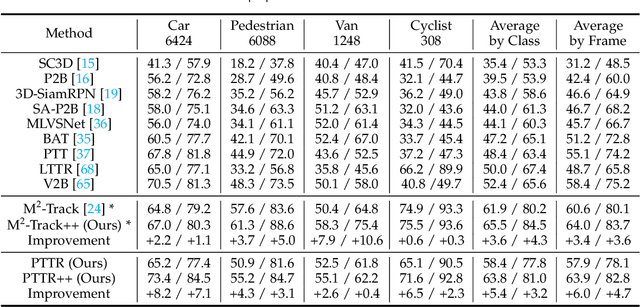


Abstract:With the prevalence of LiDAR sensors in autonomous driving, 3D object tracking has received increasing attention. In a point cloud sequence, 3D object tracking aims to predict the location and orientation of an object in consecutive frames given an object template. Motivated by the success of transformers, we propose Point Tracking TRansformer (PTTR), which efficiently predicts high-quality 3D tracking results in a coarse-to-fine manner with the help of transformer operations. PTTR consists of three novel designs. 1) Instead of random sampling, we design Relation-Aware Sampling to preserve relevant points to the given template during subsampling. 2) We propose a Point Relation Transformer for effective feature aggregation and feature matching between the template and search region. 3) Based on the coarse tracking results, we employ a novel Prediction Refinement Module to obtain the final refined prediction through local feature pooling. In addition, motivated by the favorable properties of the Bird's-Eye View (BEV) of point clouds in capturing object motion, we further design a more advanced framework named PTTR++, which incorporates both the point-wise view and BEV representation to exploit their complementary effect in generating high-quality tracking results. PTTR++ substantially boosts the tracking performance on top of PTTR with low computational overhead. Extensive experiments over multiple datasets show that our proposed approaches achieve superior 3D tracking accuracy and efficiency.
PTTR: Relational 3D Point Cloud Object Tracking with Transformer
Dec 07, 2021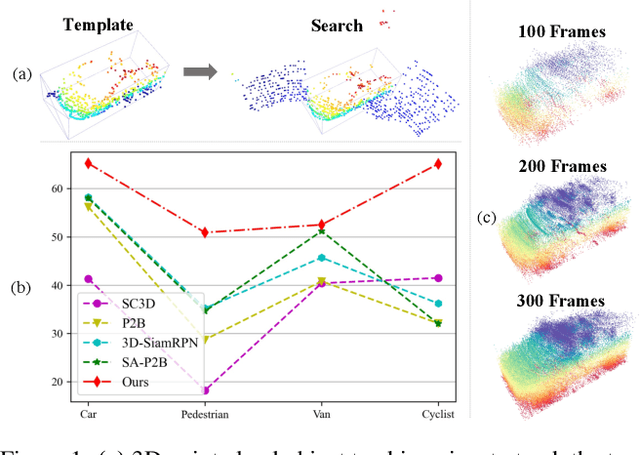



Abstract:In a point cloud sequence, 3D object tracking aims to predict the location and orientation of an object in the current search point cloud given a template point cloud. Motivated by the success of transformers, we propose Point Tracking TRansformer (PTTR), which efficiently predicts high-quality 3D tracking results in a coarse-to-fine manner with the help of transformer operations. PTTR consists of three novel designs. 1) Instead of random sampling, we design Relation-Aware Sampling to preserve relevant points to given templates during subsampling. 2) Furthermore, we propose a Point Relation Transformer (PRT) consisting of a self-attention and a cross-attention module. The global self-attention operation captures long-range dependencies to enhance encoded point features for the search area and the template, respectively. Subsequently, we generate the coarse tracking results by matching the two sets of point features via cross-attention. 3) Based on the coarse tracking results, we employ a novel Prediction Refinement Module to obtain the final refined prediction. In addition, we create a large-scale point cloud single object tracking benchmark based on the Waymo Open Dataset. Extensive experiments show that PTTR achieves superior point cloud tracking in both accuracy and efficiency.
Playing for 3D Human Recovery
Oct 14, 2021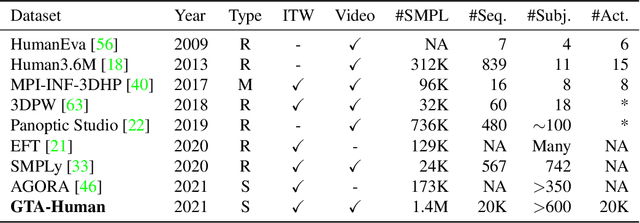
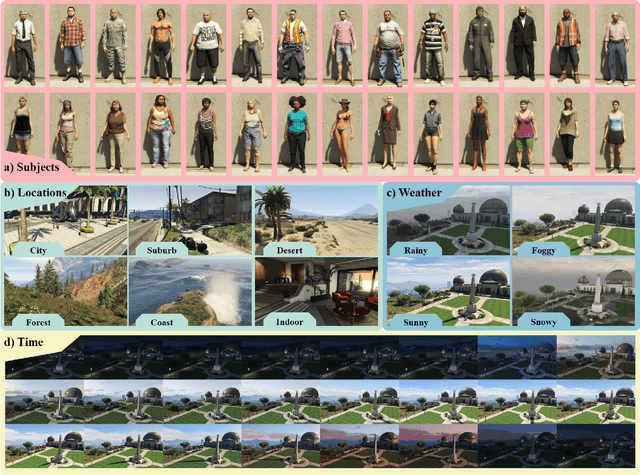

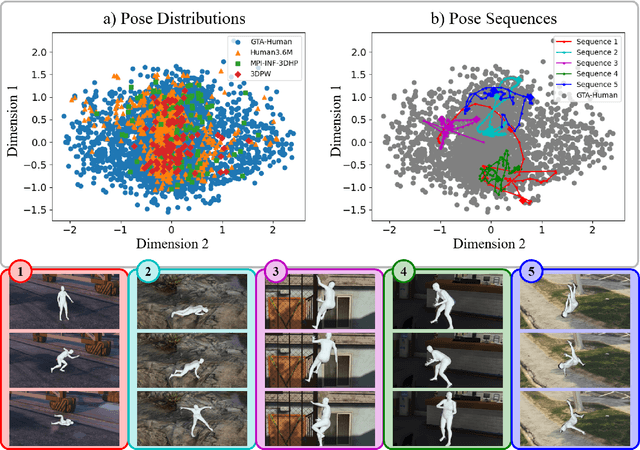
Abstract:Image- and video-based 3D human recovery (i.e. pose and shape estimation) have achieved substantial progress. However, due to the prohibitive cost of motion capture, existing datasets are often limited in scale and diversity, which hinders the further development of more powerful models. In this work, we obtain massive human sequences as well as their 3D ground truths by playing video games. Specifically, we contribute, GTA-Human, a mega-scale and highly-diverse 3D human dataset generated with the GTA-V game engine. With a rich set of subjects, actions, and scenarios, GTA-Human serves as both an effective training source. Notably, the "unreasonable effectiveness of data" phenomenon is validated in 3D human recovery using our game-playing data. A simple frame-based baseline trained on GTA-Human already outperforms more sophisticated methods by a large margin; for video-based methods, GTA-Human demonstrates superiority over even the in-domain training set. We extend our study to larger models to observe the same consistent improvements, and the study on supervision signals suggests the rich collection of SMPL annotations is key. Furthermore, equipped with the diverse annotations in GTA-Human, we systematically investigate the performance of various methods under a wide spectrum of real-world variations, e.g. camera angles, poses, and occlusions. We hope our work could pave way for scaling up 3D human recovery to the real world.
CSG-Stump: A Learning Friendly CSG-Like Representation for Interpretable Shape Parsing
Aug 25, 2021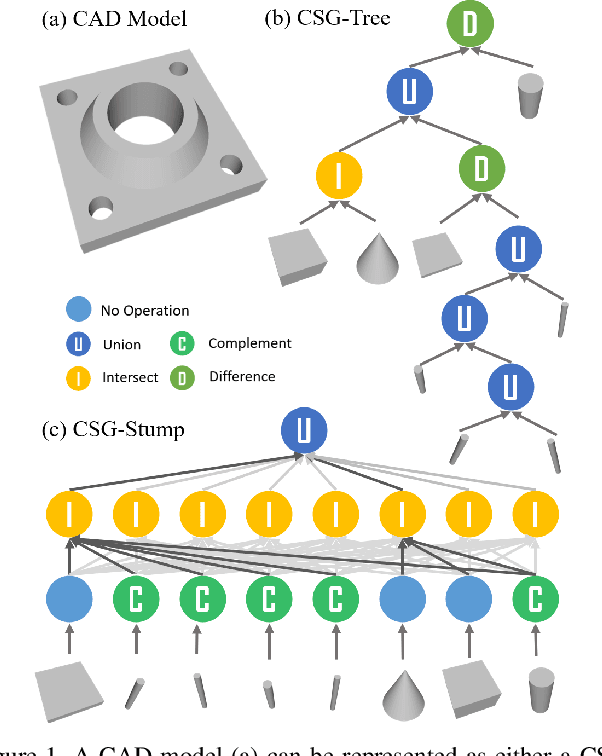

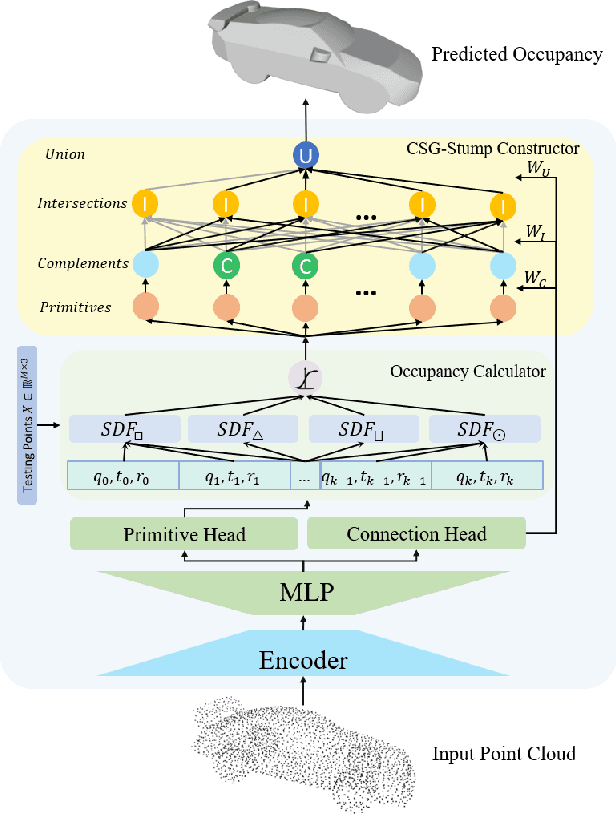
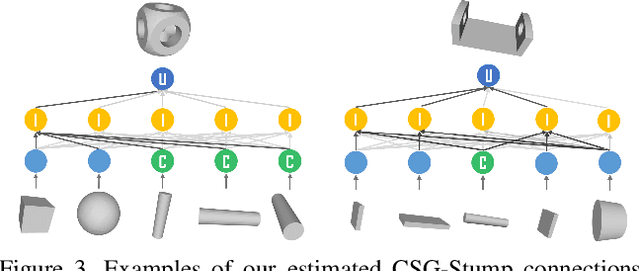
Abstract:Generating an interpretable and compact representation of 3D shapes from point clouds is an important and challenging problem. This paper presents CSG-Stump Net, an unsupervised end-to-end network for learning shapes from point clouds and discovering the underlying constituent modeling primitives and operations as well. At the core is a three-level structure called {\em CSG-Stump}, consisting of a complement layer at the bottom, an intersection layer in the middle, and a union layer at the top. CSG-Stump is proven to be equivalent to CSG in terms of representation, therefore inheriting the interpretable, compact and editable nature of CSG while freeing from CSG's complex tree structures. Particularly, the CSG-Stump has a simple and regular structure, allowing neural networks to give outputs of a constant dimensionality, which makes itself deep-learning friendly. Due to these characteristics of CSG-Stump, CSG-Stump Net achieves superior results compared to previous CSG-based methods and generates much more appealing shapes, as confirmed by extensive experiments. Project page: https://kimren227.github.io/projects/CSGStump/
Unsupervised Domain Adaptive 3D Detection with Multi-Level Consistency
Aug 18, 2021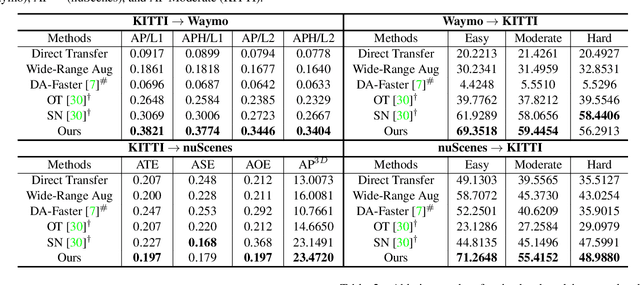

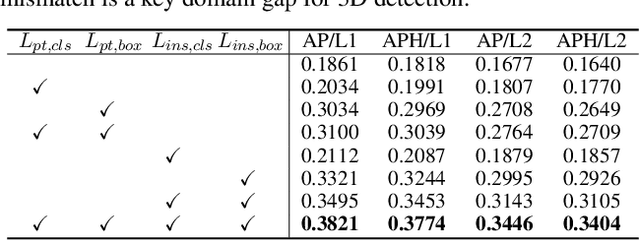
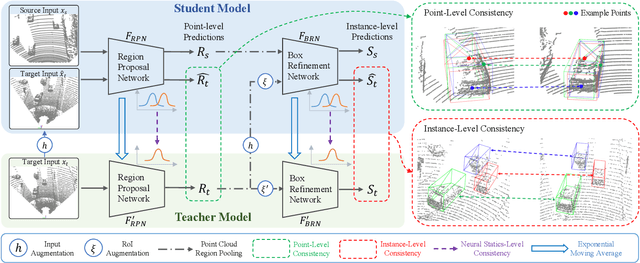
Abstract:Deep learning-based 3D object detection has achieved unprecedented success with the advent of large-scale autonomous driving datasets. However, drastic performance degradation remains a critical challenge for cross-domain deployment. In addition, existing 3D domain adaptive detection methods often assume prior access to the target domain annotations, which is rarely feasible in the real world. To address this challenge, we study a more realistic setting, unsupervised 3D domain adaptive detection, which only utilizes source domain annotations. 1) We first comprehensively investigate the major underlying factors of the domain gap in 3D detection. Our key insight is that geometric mismatch is the key factor of domain shift. 2) Then, we propose a novel and unified framework, Multi-Level Consistency Network (MLC-Net), which employs a teacher-student paradigm to generate adaptive and reliable pseudo-targets. MLC-Net exploits point-, instance- and neural statistics-level consistency to facilitate cross-domain transfer. Extensive experiments demonstrate that MLC-Net outperforms existing state-of-the-art methods (including those using additional target domain information) on standard benchmarks. Notably, our approach is detector-agnostic, which achieves consistent gains on both single- and two-stage 3D detectors.
 Add to Chrome
Add to Chrome Add to Firefox
Add to Firefox Add to Edge
Add to Edge